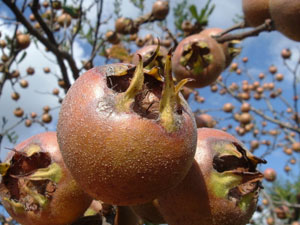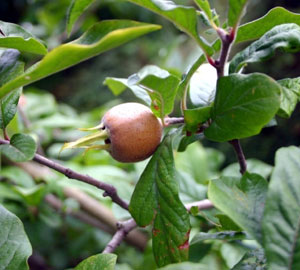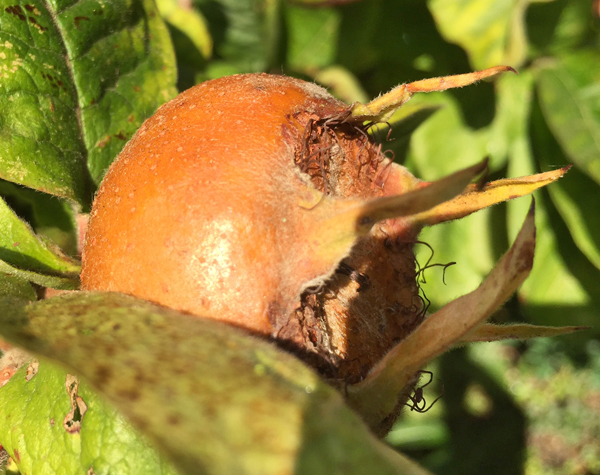Medlars

BBC's Country file recently featured a report on Medlars. The Medlar tree (Mespilus germanica) was probably a Roman import. In the 'dark ages' and Mediaeval times, the winter months probably did not offer many opportunities for fresh fruits and / or vegetables; and people were likely to become deficient in vitamin C (scorbutic), as winter progressed.
One source of 'fresh' fruit late in autumn was the medlar tree. The medlar fruit looks like a cross between a rose hip and a small apple (its french name is "cul de chien" ). The fruit is not really edible when picked 'fresh' from the tree; they are usually harvested in late October or November before the first frosts. The fruit is edible once it has been 'bletted'; i.e. harvested and then left to soften for two to three weeks,. This allows the flesh of the fruit to become a soft brown colour. The taste is a mixture of flavours - apple, vanilla, spices, toffee, a natural compote !
A mature medlar tree can yield some 80 to 90 kilos of fruit. Though they were eaten as a fruit in the past, nowadays, medlars are more likely to be used to make a 'jelly' or preserve, to be served with cold meats or game.
 There are various recipes for making medlar jelly. They involve chopping up the fruit and simmering (with some chunks of lemon) to extract the juice, straining then adding sugar, boiling and finally allowing to set. One particular recipe can be found on the RHS site :
There are various recipes for making medlar jelly. They involve chopping up the fruit and simmering (with some chunks of lemon) to extract the juice, straining then adding sugar, boiling and finally allowing to set. One particular recipe can be found on the RHS site :
http://www.rhs.org.uk/Gardening/Grow-Your-Own/Eating-and-cooking/Nigel-Slater/Recipes/Medlar-jelly but a bit of surfing yields a number of recipes - often involving combinations of medlars and apples.
Medlars (Mespilus germanica) are ornamental trees with a pretty blossom. They may be sold grafted onto a different root stock (hawthorn or quince), which is said to produce a tree of better height and spread - the natural form of the Medlar tends to have a rather spreading habit, which can be damaged in strong winds. Medlars tend to like a sunny position, but will grow in partial shade.
For further details visit : http://apps.rhs.org.uk/advicesearch/profile.aspx?pid=131

Medlar fruit
Comments are closed for this post.
Discussion
[…] The sepals too are hairy and persist on the fruit (see photo). The fruits (more about these here) are hard and acidic when first formed (image below). However, with time and exposure to cold / […]
The correct name for Medlar in French is ‘Néfle’ and as you say they also have a descriptive name for them. I believe that the English used this same descriptive name in the middle ages.
The French name cul de chien roughly translates as bottom or (ruder)of the Dog) I can see where the French are coming from here but only when I read the French name. How Perceptive of them.
I’ve seen these before and saw that episode of Countryfile, I had no idea what they were before seeing that.

How do melars fair in Scotland – am on the Moray Coast so relatively sheltered?
Jay Wilson
23 January, 2017